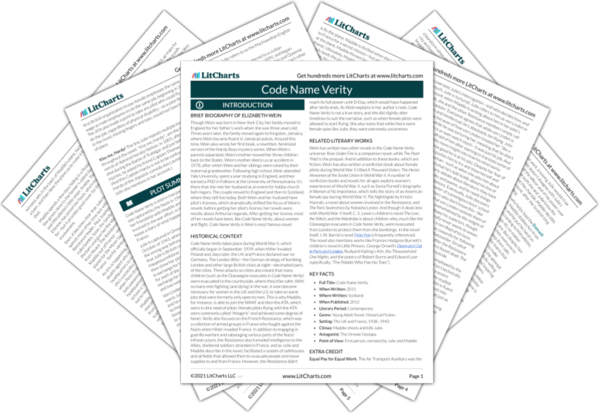Welcome to the LitCharts study guide on Elizabeth Wein's Code Name Verity. Created by the original team behind SparkNotes, LitCharts are the world's best literature guides.
Code Name Verity: Introduction
Code Name Verity: Plot Summary
Code Name Verity: Detailed Summary & Analysis
Code Name Verity: Themes
Code Name Verity: Quotes
Code Name Verity: Characters
Code Name Verity: Terms
Code Name Verity: Symbols
Code Name Verity: Theme Wheel
Brief Biography of Elizabeth Wein

Historical Context of Code Name Verity
Other Books Related to Code Name Verity
- Full Title: Code Name Verity
- When Written: 2011
- Where Written: Scotland
- When Published: 2012
- Literary Period: Contemporary
- Genre: Young Adult Novel, Historical Fiction
- Setting: The UK and France, 1938–1943
- Climax: Maddie shoots and kills Julie.
- Antagonist: The Ormaie Gestapo
- Point of View: First person, narrated by Julie and Maddie
Extra Credit for Code Name Verity
Equal Pay for Equal Work. The Air Transport Auxiliary was the first British organization to pay female employees the same wage as male employees to do the same job, beginning in 1943. The ATA also made a point to take any pilot who could fly and do the job, regardless of physical disability—so a pilot like Jamie in the novel, missing fingers and toes, would not have been out of place.
Kiss me, Hardy! The line Julie repeats multiple times throughout the novel, “Kiss me, Hardy!”, are the famous last words of Admiral Horatio Nelson. In 1805, after Nelson was shot during the Battle of Trafalgar and just before he died of his injuries, he asked his friend Captain Thomas Hardy to kiss him. (And this Captain Hardy is not to be confused with Oliver Hardy of the slapstick comedy duo Laurel and Hardy, whom Julie also mentions in her account.)







